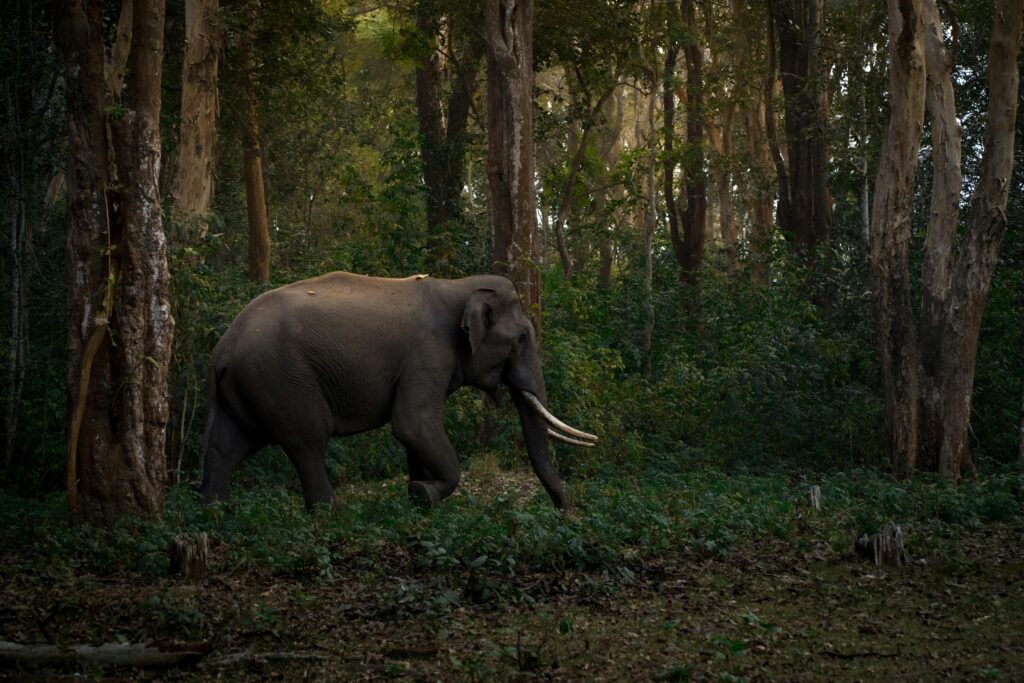
Guwahati, Assam:
In a heartwarming display of coordination between forest officials and local villagers, an elephant calf was successfully rescued from a remote forested area in Assam after being separated from its herd. The incident, which unfolded in the early hours of Thursday in the fringes of the Kaziranga National Park, has once again brought attention to the growing challenges faced by India’s wild elephant population — and the tireless efforts of those who protect them.
The Discovery in the Early Hours
The calf, believed to be around 8 to 10 months old, was first spotted by villagers near the outskirts of the Bagori Range in Nagaon district. Early risers had noticed unusual rustling sounds in the bamboo groves adjacent to a tea estate. Upon closer inspection, they were surprised and concerned to find a lone elephant calf wandering aimlessly and trumpeting softly — a telltale sign of distress.
Without any adult elephants in sight, the villagers alerted the Forest Department. Within hours, a rescue team led by forest ranger Anupam Borthakur, along with veterinary officers and local wildlife NGO workers, reached the scene.
A Delicate Rescue Operation
The team immediately cordoned off the area to avoid further stress to the calf. The forest floor was muddy from recent rains, and the surrounding terrain was dense with foliage, making movement difficult. The calf had reportedly been without its mother for over 24 hours, judging by its dehydration and signs of fatigue.
“We had to proceed with extreme caution,” said Borthakur. “Young elephants are highly sensitive, and if frightened, they can injure themselves or even run into unsafe areas like nearby tea gardens or roads.”
A temporary enclosure was set up using bamboo and canvas sheets, and the calf was gently guided into the safe zone with the help of banana leaves and sugarcane. Tranquilizers were avoided to ensure the calf remained alert and unharmed. Once secured, the veterinary team conducted a preliminary health check, noting slight dehydration but no major injuries.
How the Calf Got Lost
Preliminary assessments suggest the elephant herd, likely migrating through the forest corridor near the Panbari Reserve, may have been startled by human activity or vehicle noise. The area has seen increased encroachment and movement of heavy trucks due to nearby roadwork, which often disrupts the natural paths of wildlife.
“In such chaos, it’s common for a young one to lag behind,” explained wildlife expert Dr. Namita Gogoi, who was part of the rescue team. “When adult elephants sense danger, they instinctively flee with the core group. Calves, due to their smaller size and slower pace, are sometimes unintentionally left behind.”
Local Community: Guardians of the Wild
What makes this story even more remarkable is the crucial role played by the local villagers. Instead of approaching the calf or attempting to drive it away — which often happens out of fear — the community acted responsibly and immediately informed authorities.
“This shows how awareness and outreach programs in recent years have made an impact,” noted conservationist Arup Saikia, who has worked with communities in the region for over a decade. “Ten years ago, the situation might have ended very differently.”
Locals were even seen volunteering to help carry supplies for the rescue team and ensured the crowd stayed at a respectful distance to reduce stress on the animal.
Plans for Reunion with the Herd
The primary goal of the forest department was not just to rescue the calf but also to reunite it with its original herd — a challenging but not impossible task. Using recent elephant tracking data, forest officials traced the likely route of the herd and placed camera traps in key zones to monitor their movements.
“Reuniting a calf with its herd requires patience and precision,” said Dr. Gogoi. “Elephants have an excellent memory and strong familial bonds. If we can locate the herd and safely release the calf in their proximity, there is a good chance they will accept it back.”
As of Friday evening, drone surveillance and field teams were deployed in coordination to locate the herd, which was last sighted in a forest patch about five kilometers away.
Wider Issues at Play
This incident, while ending on a hopeful note, sheds light on the larger issues threatening elephant populations in India. Habitat fragmentation, human encroachment, and infrastructure development continue to disrupt elephant corridors — the traditional migratory paths that herds have used for centuries.
Assam alone is home to over 5,000 wild elephants, many of which depend on these fragile corridors to move between forest patches. Increased human presence along these paths often leads to conflict, injuries, and in tragic cases, death — both for elephants and people.
A Glimpse of Hope
Despite these challenges, moments like the successful rescue of this calf remind us of the positive outcomes that are possible when local communities, forest officials, and wildlife experts work together. With proper planning, awareness, and sensitivity, it is possible to coexist peacefully with wild animals even in areas where human and wildlife territories overlap.
“Conservation isn’t just about animals — it’s about people too,” said Saikia. “It’s about compassion, quick thinking, and respect for the natural world.”
What Happens Next?
The elephant calf will remain under observation for a few days while the department continues efforts to locate and reunite it with its herd. In case a reunion is not possible, it may be shifted to a rehabilitation center such as the Centre for Wildlife Rehabilitation and Conservation (CWRC) in Kaziranga, where it can be raised with other rescued elephants until it is ready for rewilding.
The Forest Department has also announced plans to strengthen patrolling in the area, improve signage for vehicle drivers, and conduct further outreach programs in nearby villages to minimize future incidents.
For now, the young calf — tired but safe — stands as a symbol of hope in Assam’s ever-unfolding story of human-wildlife coexistence.